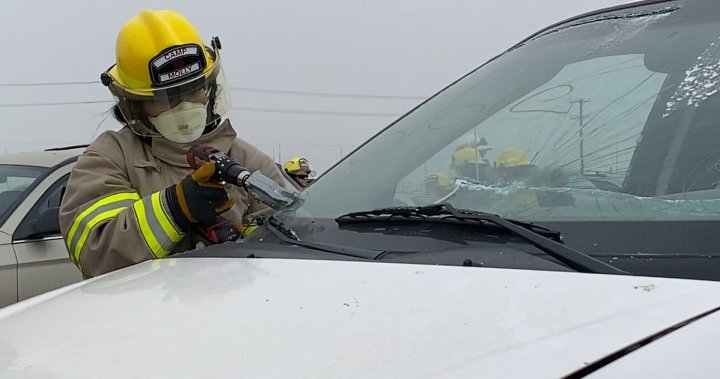The early morning alarm rings at 5:30 a.m. Teens scramble into their gear, ready to face mock emergencies that would make many adults hesitate. This isn’t military school – it’s Camp Molly, an innovative firefighting program that’s quietly reshaping what leadership looks like for female and non-binary youth across Canada.
“I never thought I’d be pulling a 175-pound dummy from a smoke-filled room,” says Jasmine Chen, 16, wiping sweat from her brow after completing a training exercise. “Now I’m thinking maybe I could be a firefighter someday.”
That transformation from uncertainty to confidence is exactly what Camp Molly aims to deliver. Named after Molly Gallant, the first female firefighter in Ontario’s history, the program offers hands-on experience in a field where women represent just 5 percent of Canada’s firefighting workforce, according to Statistics Canada‘s latest employment figures.
Last weekend, I visited the Toronto Fire Academy where 40 participants aged 15-19 were rappelling down towers, operating powerful hose lines, and learning crucial emergency response techniques. What struck me wasn’t just their growing technical skills, but the unmistakable pride developing with each successful exercise.
“These young people aren’t just learning to fight fires,” explains Battalion Chief Rayna Thomson, who has championed the program since its inception four years ago. “They’re discovering their own capacity to handle pressure, work as a team, and lead during chaos – skills that translate to any career path.”
Thomson isn’t exaggerating. Camp applications have doubled each year, with waiting lists now extending into 2025. The program’s success has sparked similar initiatives in Vancouver, Edmonton, and Halifax – creating a nationwide movement to diversify emergency services.
The impact extends beyond individual participants. Research from the Canadian Association of Fire Chiefs shows departments with diverse membership respond more effectively to community needs. When emergency services reflect the communities they serve, public trust improves and more lives are saved.
“Our neighborhoods change when young people see themselves represented in positions of authority,” notes Dr. Marcus Williams, who studies diversity in public safety at Ryerson University. “Camp Molly creates that critical visibility while addressing practical barriers to recruitment.”
Those barriers remain substantial. Despite some progress, a 2023 survey by the Canadian Centre for Diversity and Inclusion found that 64 percent of female firefighters reported experiencing gender-based discrimination during their careers. Programs like Camp Molly aim to change this culture from the ground up.
The four-day camp doesn’t sugarcoat the physical demands. Participants carry equipment weighing up to 45 pounds while navigating obstacle courses. They practice search techniques in darkened, smoke-filled environments. They learn the science behind fire behavior while developing practical response protocols.
“We had one participant who couldn’t complete a single push-up on day one,” recalls volunteer instructor Elena Rodriguez, a 12-year veteran with Ottawa Fire Services. “By day four, she led her team through a full rescue scenario. That’s the transformation we’re after.”
The program also highlights less obvious aspects of modern firefighting. Participants learn about mental health support for first responders, environmental considerations during chemical incidents, and community education strategies.
Funding remains a challenge despite growing recognition. The program relies heavily on donations from firefighter associations and community partners. Each camp costs approximately $35,000 to run, with organizers committed to keeping participation free for all attendees.
“We can’t ask these young people to pay,” explains Thomson. “Many come from households where spare money doesn’t exist. The moment we introduce fees is the moment we lose the diversity this program was designed to create.”
Provincial governments have noticed the program’s success. Last month, Ontario’s Ministry of Community Safety pledged $150,000 to expand Camp Molly to five additional cities over the next two years. Saskatchewan and Manitoba are considering similar investments.
For participants like Aisha Olanrewaju, 17, the experience goes beyond career exploration. “Before Camp Molly, I hesitated to speak up in groups,” she tells me during a lunch break. “Now I’m directing a team through rescue operations. That confidence follows me everywhere.”
The program’s impact extends into school performance. Follow-up surveys with past participants show 78 percent reported improved grades in science and mathematics after attending, with many citing newfound appreciation for the practical applications of these subjects.
As Canada faces growing challenges from climate-related emergencies and an aging first responder workforce, initiatives like Camp Molly address multiple societal needs simultaneously. They create pathways for underrepresented groups while strengthening emergency response capabilities nationwide.
“We’re not just training tomorrow’s firefighters,” Thomson says as we watch participants tackle their final day challenges. “We’re building community leaders who understand crisis management, teamwork, and calm decision-making under pressure.”
As the sun sets on another successful camp session, I watch these young people – tired but triumphant – remove their heavy gear one last time. Some will pursue careers in emergency services. Others will take their newfound confidence into entirely different fields. But all leave with something invaluable: the knowledge that when faced with life’s fires, they have what it takes to respond.






